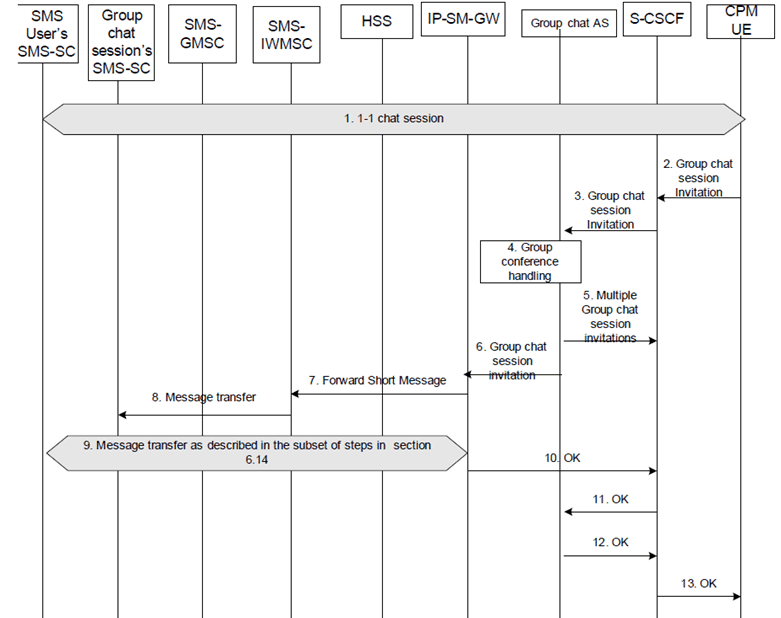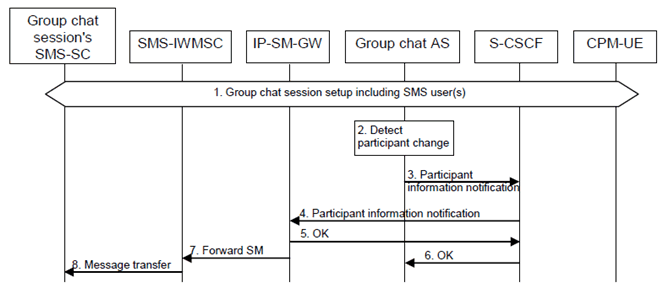Content for TS 23.204 Word version: 17.0.0
B.2 Service-level interworking: CPM user extends a one-to-one chat session into a group chat session
B.3 Service-level interworking: IP-SM-GW informs SMS users about group chat participant changes
$ Change history
B.2 Service-level interworking: CPM user extends a one-to-one chat session into a group chat session p. 56
This flow is the same as that described in clause 6.15.1 with the difference that it is required that the IP-SM-GW assign an MSISDN when this group chat session starts if one was not assigned before, so that it is clear for the SMS user that any message sent to the assigned MSISDN will be delivered to the group chat session participants, not just to the CPM UE that invited the SMS user.
In this flow, the IP-SM-GW is in the PLMN of the CPM UE, but it could also be in the PLMN of the SMS user if that user was also a CPM user and had terminating user preferences to deliver the session invitation via SMS.

Figure B.2: CPM user modifies a one-to-one chat session into a group chat session
(⇒ copy of original 3GPP image)
(⇒ copy of original 3GPP image)
Step 1.
A one-to-one chat session is established between the CPM user and the SMS user.
Step 2.
The UE generates a chat session invitation which includes a recipient list in the body of the chat session invitation. The original SMS user who is part of the one-to-one chat session is included in that list An indication is added for the original SMS user in the list that the existing one-to-one session is to be replaced by the new session. The UE submits the chat session invitation to the S-CSCF.
Step 3.
Based on the stored iFC, S-CSCF forwards the session invitation to an AS in charge of handling group chat requests, e.g., the controlling function server defined in OMA-TS-SIMPLE_IM-V1_0 [12] or the controlling function server defined in OMA-TS-CPM_Conv_Fnct-V1_0 [17].
Step 4.
The group chat AS replicates a session invitation per recipient according to the group information it obtains acting as a B2BUA. See details in OMA-TS-SIMPLE_IM-V1_0 [12] or in OMA-TS-CPM_Conv_Fnct-V1_0 [17].
Step 5.
The group chat AS sends the generated multiple session invitations to the S-CSCF.
Step 6.
The group chat AS sends one of the chat session invitations to the IP-SM-GW according to normal routing procedures (e.g., via S-CSCF). The chat session invitation will indicate that the existing session is to be replaced with a new session.
Step 7.
The IP-SM-GW translates the chat session invitation request to a Short Message (SMS- SUBMIT) and forwards it towards the group chat SMS-SC (SC Address) via the SMS-IWMSC (as described in TS 23.040). The IP-SM-GW assigns an MSISDN representing the group chat session, if one was not assigned for the one-to-one chat session, to ensure that the reply to this SMS is sent back to this particular IP-SM-GW. Any SMS sent from the SMS user to this MSISDN will be interworked into the group chat session with which this MSISDN is correlated. The text in the Short Message is defined by the operator and conveys information to the SMS user that the one-to-one session has been transformed into a group session and that he is invited to send and receive messages in the context of a group chat session, and includes instructions on how to accept, reject and end the session. The identity of the original sender (CPM user or group) is included as part of the operator provided invitation text.
Step 8.
The SMS-IWMSC forwards the Short Messages (SMS- SUBMIT) to the group chat SMS-SC and the SMS is delivered to the SMS user using standard SMS procedures (see TS 23.040).
Step 9.
A Short Message is received from the SMS user via the SMS-GMSC by the IP-SM-GW, in accordance to steps 2 to 4 and steps 10 to 13 from clause 6.14, indicating the response to the group chat session invitation. The message is targeted to the MSISDN representing the group chat session which was assigned in step 7.
Step 10.
If the answer is positive or if operator policy is to accept the session invitation on behalf of the SMS user, the IP-SM-GW acknowledges the session invitation. Otherwise the IP-SM-GW will consider the session rejected and sends back an appropriate response.
Step 11.
The session invitation acknowledgement is forwarded by S-CSCF to the group chat AS.
Step 12-13.
The group chat AS responds back to the group chat session initiator once the first user joins the group chat session.
B.3 Service-level interworking: IP-SM-GW informs SMS users about group chat participant changes p. 57
In this flow, the IP-SM-GW is in the PLMN of the CPM UE, but it could also be in the PLMN of the SMS user if that user was also a CPM user and had terminating user preferences to deliver the session invitation via SMS.

Figure B.3: Sending participant information changes to an SMS user in a group chat session
(⇒ copy of original 3GPP image)
(⇒ copy of original 3GPP image)
Step 1.
A group chat session including SMS user(s) set up by an IM or CPM user as described in clause B.1 steps 1-17.
Step 2.
The group chat AS detects change in participants of the group chat session (e.g. participant added or left the group chat session, that event is not shown in the flow).
Step 3-4.
As the IP-SM-GW has subscribed to participant information changes, the group chat AS notifies the IP-SM-GW about the participant change through the S-CSCF using an appropriate SIP method.
Step 5-6.
The IP-SM-GW acknowledges the notification.
Step 7.
According to operator policy, the IP-SM-GW translates the participant change notification to a Short Message (SMS- SUBMIT) and forwards it towards the group chat SMS-SC (SC Address) via the SMS-IWMSC (as described in TS 23.040). The text in the Short Message is defined by the operator and conveys appropriate information to the SMS user.
Step 8.
The SMS-IWMSC forwards the Short Messages (SMS- SUBMIT) to the group chat SMS-SC and the SMS is delivered to the SMS user using standard SMS procedures (see TS 23.040).